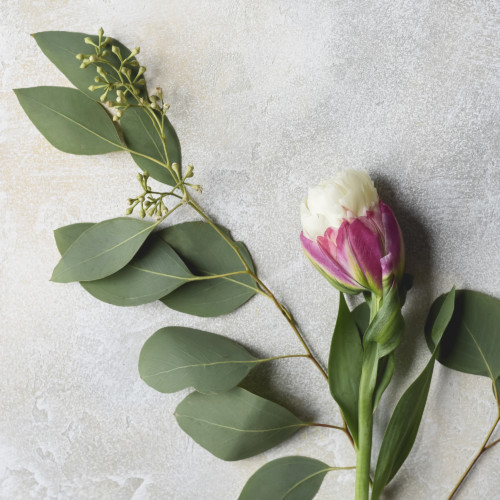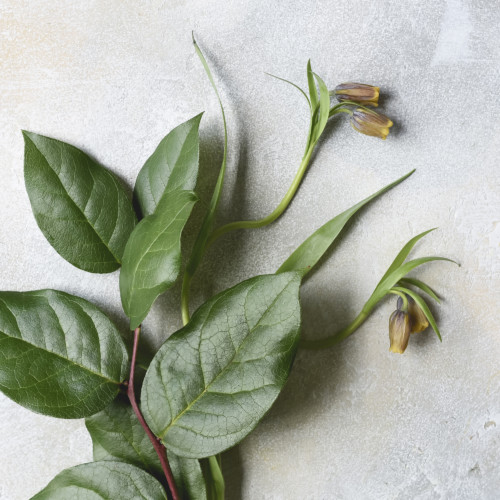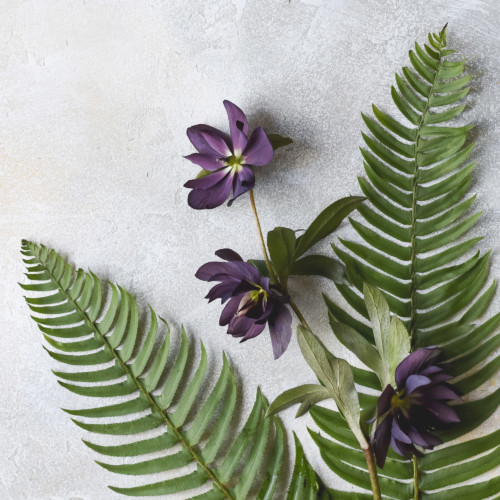
Ask Ella: The Basic Bouquet Fillers Everyone Should Know
Ask Ella is a recurring Garden Collage feature where we ask our in-house florist, Ella Stavonsky, about floral design– including the history of, origin, and maintenance that goes into some of the most intriguing flowers on the market today. This column is dedicated exclusively to common and rare varieties of flowers you’re likely to find at your local market. This week, we spotlight the big three fillers: eucalyptus, lemon leaves, and ferns.
Eucalyptus
The darling of every Pinterest bouquet, eucalyptus comes in a variety of shapes and sizes, but the most common type you’re likely to see is silver dollar eucalyptus, which hangs in elegant, willowy branches (pictured here). It’s an excellent option for smaller arrangements, as it tends to come with many segments to stem, which can each be cut and worked in without breaking the bank. That isn’t to say it doesn’t work for larger arrangements– but it can get a little unwieldy, as the different branches can weigh themselves down and go every which way, so if you’re using silver dollar eucalyptus in a larger bouquet, anchor it firmly with [easyazon_link identifier=”B001K7QAYM” locale=”US” tag=”gardcoll03-20″]floral wire[/easyazon_link].
In bouquets, eucalyptus works best when trying to evoke a slightly wild, gathered-straight-from-the-field look. When selecting for central blooms, opt for flowers you’re likely to see (or wish you would see) growing outdoors, like cottage roses, sweet peas, viburnum, or tulips (we opted for ice cream tulips here, as they are a cheaper alternative to peonies, but have the same lush effect).
Lemon Leaves
Compared to ferns and eucalyptus, lemon leaves are trickier to use and are less common in bouquets, as they tend to have “a good side” which is shiny, and has an almost lacquered look about it, and a “bad side”, which is a paler, drier green. When using them in bouquets, this translates to being more careful about how and where they’ll face in bouquets but shouldn’t scare you off– after all, don’t we all have a good and bad side?
Lemon leaves are best for more traditional bouquets, and are typically used around the outside of bouquets, almost like an exterior layer, rather than being woven in to the bouquet itself. Of course, that doesn’t mean you can’t use them throughout bouquets, it’s just easier to use them along the outside, as this offers an angle and position where their shiny side faces up, and their less favorable side faces away from view. For this reason, they tend to work best in handheld, more architectural bouquets, where they are well below eye level and mostly viewed from above or directly above, such that their shiny leaves fan out along the edges. Pair them more classic flowers, like standard roses in pale colors, white hydrangeas, or white stock flower.
Ferns
If you’re feeling a little mysterious, or want a bit more of a woodland, fantastical look, ferns are the way to go. There are a variety of shapes to choose from, but most come in dark, full shades of green, meaning they pair well with other dark colored flowers– like the deep purple hellebores below, or else clematis, dark Queen Anne’s Lace, or else anything in the purple family anything or that seems to have a touch of magic or healing about it. (When we made bouquets for our Botany Salon, we even added in ornamental chili peppers.)
As there is quite a bit of diversity among ferns, you can use them in arrangements of different sizes. A single fern sprig (like that picture above) works well in medium arrangements to add a structural and textural flare. Softer ferns, meanwhile, can work in arrangements of all different sizes, and add a lightness no matter where they go. Just remember to clean the ends thoroughly, and mist them once a day in addition to refreshing the water.
Read to put your knowledge to the test? Try incorporating your greens into a botanical chandelier.




































